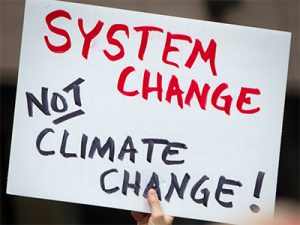NAFTA renegotiations must be done through the lens of climate change

Canada, and not just Mexico, may be in for a rough ride when it renegotiates NAFTA with the United States. A draft letter from the U.S. Trade Representative to Congress outlining renegotiation objectives, which was leaked on March 30, reveals that the U.S. agenda goes far beyond the modest tweaking implied earlier by President Trump.
When it comes to fighting climate change, however, the ride will be rougher. Trade provisions will likely continue to be a stumbling block in any efforts to curb greenhouse gas emissions.
Observers note that the U.S. has no intention of doing away with the notorious investor state dispute settlement (ISDS) provisions that allow corporations to sue governments when they deem public policies — such as those aimed at fighting climate change — to be a threat to their profits. Corporations, chiefly chemical and resource extraction companies, sued Canada 39 times under this mechanism, collecting more than $215 million in compensation. Ottawa will likely not push for the elimination of ISDS from NAFTA since it has agreed to a slightly modified ISDS system in the Comprehensive Economic and Trade Agreement with the European Union.
Additionally, a crucial chapter incorporated into the original Canada-U.S. Free Trade Agreement (FTA), and now part of NAFTA, has escaped notice in current debate. Chapter Six on energy gives the U.S. unfettered access to Canadian energy resources.
During the 1993 election campaign Jean Chrétien promised that a Liberal government would renegotiate both the FTA and NAFTA and abrogate both agreements unless Canada were to obtain “the same energy protection as Mexico.”
A careful reading of the energy chapter in NAFTA shows that the only significant difference in the treatment of Mexico and Canada is the former’s exemption from the application of the proportional sharing clause (Article 605). This provision obliges Canada, under certain circumstances, to continue exporting oil and gas to the U.S. in the same proportion as in the previous three years, even if such exports cause domestic shortages.
After Chrétien won a majority government some perfunctory talks were held with the U.S. before this campaign promise was quietly shelved allowing the proportional sharing clause to remain unchanged.
While this clause has yet to be invoked, it very well could be in the near future if Canada fulfills its commitments under the Paris climate agreement. If Canada is serious about keeping the increase in global temperatures below 2.00 C, and as close as possible to 1.50 C, it will have to curb the unfettered growth of fossil fuel exports and carefully allocate remaining reserves of conventional oil for domestic use as part of a planned transition to a low-carbon economy.
Measures to conserve exhaustible natural resources for domestic use are permitted under Article XX of the GATT, which is now part of the World Trade Organization’s provisions. But they would run afoul of the proportional sharing clause.
Will the current Liberal government include the withdrawal of the proportional sharing clause in its agenda for the renegotiation of NAFTA? Not likely. During his visit to the White House, Prime Minister Justin Trudeau did his utmost to assure President Trump that it is in U.S. interests to continue the current trading relationship with Canada.
In Trump’s mind Canadian oil is not “foreign oil.” Consider the president’s words, spoken in the oval office in the presence of Russ Girling, TransCanada’s president, as he issued the permit for the Keystone XL pipeline:
“It’s a great day for American jobs and a historic moment for North American … energy independence. This announcement is part of a new era of American energy policy that will lower costs for American families — and very significantly — reduce our dependence on foreign oil.”
The additional emissions that would occur within Canada as a result of four recently approved fossil fuel export projects — Enbridge’s Line 3, TransCanada’s Keystone XL and Kinder Morgan’s Trans Mountain pipelines as well as the Pacific Northwest LNG terminal — would nullify all the emission reductions that could be achieved through the Pan-Canadian Framework on Clean Growth and Climate Change announced last December by federal, provincial and territorial first ministers. The emissions that would occur abroad from combustion of the oil and gas exported by these four projects would not be counted as “Canadian” emissions. Nevertheless, they would add two times as many GHGs to the atmosphere as the amount emitted within Canada.
The time frame during which Canada can continue to emit GHGs at current rates and still keep temperature increases near 1.50 C is quickly narrowing. If Canada continues to extract fossil fuels at 2014 levels it will exhaust its share of a global carbon budget in just 11 years if the goal is to keep temperature increases below 1.50 C. According to Marc Lee, a senior economist for the Canadian Centre for Policy Alternatives, in this scenario, there is only a 50 per cent chance of keeping increases below 1.50 C. For a 50 percent chance of staying below a 2.00 C increase, Canada could extract fossil fuels at the 2014 rate for 32 years. Any new hydrocarbon export projects would shorten these time frames.
While no one was thinking much about climate change back in the eighties when the FTA was negotiated, today the threat it poses to life on Earth must be a lens through which any new deal is evaluated.
Originally published in the Huffington Post on April 20, 2017, by John Dillon, Ecological Economy Program Coordinator at KAIROS Canada.
The views expressed are those of the authors and do not necessarily reflect the views of CCIC or its members.







